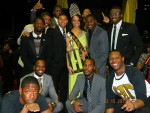 Post Classifieds
Post Classifieds
State Fair historically segregated
As Prairie View alumni and students celebrated a victory against Grambling last weekend at the State Fair Cotton Bowl game, they also commemorated a history when blacks were not allowed on the fairgrounds let alone the turf.
Sept. 18, 1889 denotes the first day when blacks were allowed to attend the fair, aside from whites, on Colored People's Day.
In 1910 Colored People's Day was suspended to only reappear in 1936 as Negro Achievement Day.
This day mirrored the Texas Centennial Exposition, commemorating the 100th anniversary of Texas accession from Mexico in 1836.
Negro Achievement Day is the only day that allowed for colored admission onto fairgrounds yet this time around fair and government officials were comforted by the racial exclusion, claiming the day as a dedication to the achievements of people of color in the state of Texas and throughout the nation.
"In Indiana, I remember a day similar to Colored People's Day, but a day like that was pervasive across the country during that time. It marked the beginning of desegregation yet we were still segregated," said Steven Ransom, director of student engagement.
Celebrating the steps toward desegregation The Hall of Negro Life was an urged addition to the fair by the Dallas Negro Chamber of Commerce to give factual support to black achievement. This was done by showing artifacts and memorialized exhibits of black progress in education, progress in curtailing diseases, agriculture, mechanic arts, business and industry, and art.
Carrying contributions from 32 states and the District of Columbia, The Hall of Negro Life served as history lesson for more than 400,000 visitors, some 40 percent white.
Although Texas institutions sent students to the hall to observe the exhibits, The Hall of Negro Life was the only building destroyed when the centennial celebration ended.
Negro Achievement Day continued for many years, beginning with a parade and ending with the presentation of the Most Distinguished Negro Citizen Award.
"There is no accomplishment in that award, it comes with restrictions. The Most Distinguished Negro rather than the Most Distinguished Person," said Sidney LeBeauf, a sophomore civil engineering major.
If the Most Distinguished Negro Citizen Award did not denote the obvious segregation of the fair, Juanita Craft, would call it to everyone's attention in 1955 as the fair gathered for yet another year and yet another Negro Achievement Day.
In 1961 the day ended, but not until in 1967 would desegregation from the fair attractions end as well.
After 47 years marking Negro Achievement Day, the history of the day and the efforts of activists like Craft may be forgotten, but as the Panthers celebrate their first victory of the season, it calls us to remember what came before to foreshadow the victory of not only uniformed and padded athletes, but determined and diligent civil rights advocates.
Get Top Stories Delivered Weekly
More pvpanther News Articles
- Alphas win TCAC chapter of the year
- Senior project to help track campus shuttles
- Pre-med students receive white coats
- Library exhibits 'Women of a New Tribe
Recent pvpanther News Articles
Discuss This Article
MOST POPULAR PVPANTHER

Grambling snatches third win in two seasons against the Panthers By Denzel Speights

Fast start ends in epic double overtime win for Lady Panthers By Donovan Martinez

Alphas win TCAC chapter of the year By Demario Lowe
GET TOP STORIES DELIVERED WEEKLY
FOLLOW OUR NEWSPAPER
LATEST PVPANTHER NEWS
- Grambling snatches third win in two seasons against the Panthers
- Love or lust relationship seminar educates students on love
- Leisure activity turns into new organization on campus
- Fast start ends in epic double overtime win for Lady Panthers
- Alphas win TCAC chapter of the year
- Students network with companies at career fair
- Panthers give Bearkats a run for their
RECENT PVPANTHER CLASSIFIEDS
OUTSIDE THE LINES
- The Gap in Gum Care: Why Caring For Your Teeth’s F...
- Top Tips for Signature Scents and Better-Smelling Laundry
- A Dog Trainer’s Top Tips to Support Pets Through Life S...
- Clear the Air of Indoor Pollutants This Spring
- Stroke & Dementia in Black Men: Tips for Staying Healthy...
- Hispanics and African Americans at Higher Risk for Eye...
- African Americans at Higher Risk for Eye Disease
- Infinity Kings: Final Book In A Favorite Fantasy Series
- What You Need To Know About Keratoconus and the iLink...
- Your Child’s Tomorrow Begins Today
FROM AROUND THE WEB
- No Child is Forgotten By Marine Toys for Tots
- Sweeten Your Springtime Salads With Healthy Chilean Grapes
- Young Author Translates 4,000-Year-Old Text to Reveal...
- Keeping Cool and Energy-efficient Amid America’s “...
- Addressing Sarcopenia with a Healthy Diet
- Subway’s New Wraps Elevate Eating on the Go
- Family Teacher Conference Topics Beyond Academics
- Youth Take Down Tobacco
- BookTrib’s Bites: Four Reads to Kickoff Spring
- Curbing Colorectal Cancer in Minority Populations
COLLEGE PRESS RELEASES
- Shoff Promotions Comic Book & Sports Card Show
- Semiconductor Research Corp unveils 2024 Research Call, $13.8M Funding
- Charles River Associates Opens Second Scholarship Cycle, Expands to the UK
- BLUMHOUSE AND AMC THEATRES LAUNCH FIRST-EVER HALFWAY TO HALLOWEEN FILM FESTIVAL
- THE GEN Z IMPERATIVE: LISTEN TO FEELINGS AND GIVE GEN Z A VOICE












